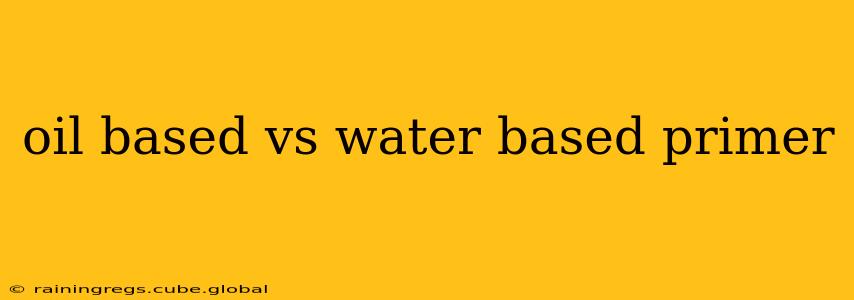Choosing the right primer can make or break your painting project. Whether you're a seasoned DIYer or a professional painter, understanding the differences between oil-based and water-based primers is crucial for achieving a flawless, long-lasting finish. This comprehensive guide will delve into the pros and cons of each, helping you make the best choice for your specific needs.
What is Primer and Why is it Important?
Before we dive into the oil-based versus water-based debate, let's establish the fundamental role of primer. Primer is a preparatory coat applied to a surface before painting. It serves several critical functions:
- Improved Adhesion: Primer creates a better bonding surface between the paint and the substrate (wall, wood, metal, etc.), preventing peeling and chipping.
- Enhanced Coverage: It provides a uniform base, leading to better paint coverage and reducing the number of coats needed.
- Surface Protection: Primer seals the surface, protecting it from stains, moisture, and other elements that could affect the paint's longevity.
- Color Uniformity: Primer can help neutralize existing colors or stains, ensuring a consistent final paint color.
Oil-Based Primer: Pros and Cons
Oil-based primers have been a staple in the painting industry for decades, known for their durability and exceptional adhesion.
Pros:
- Superior Adhesion: Oil-based primers boast excellent adhesion, particularly on surfaces like metal or wood, making them ideal for projects requiring high durability.
- Excellent Stain Blocking: They effectively seal stains, preventing bleed-through of knots in wood or watermarks on walls.
- Durable Finish: Oil-based primers create a robust, long-lasting foundation for paint.
- Works Well on Various Surfaces: Effective on a wide range of substrates including wood, metal, and previously painted surfaces.
Cons:
- Strong Odor: Oil-based primers have a pungent, lingering odor that can be unpleasant during application and drying.
- Longer Drying Time: They require significantly longer drying times compared to water-based primers.
- Cleanup: Cleaning up requires solvents like mineral spirits, adding to the cost and environmental impact.
- Flammability: Oil-based primers are flammable and require careful handling and storage.
Water-Based Primer: Pros and Cons
Water-based primers have gained popularity due to their ease of use and low environmental impact.
Pros:
- Low Odor: Water-based primers have a much milder odor, making them a more pleasant option for indoor use.
- Fast Drying Time: They dry much faster than oil-based primers, speeding up the entire painting process.
- Easy Cleanup: Cleanup is simple with just soap and water.
- Environmentally Friendly: Water-based primers are less harmful to the environment compared to their oil-based counterparts.
- Less Flammable: They are non-flammable, enhancing safety during application.
Cons:
- Lower Stain Blocking: Water-based primers may not always be as effective at blocking stubborn stains compared to oil-based options. Multiple coats may be required for intense stains.
- Less Durable on Certain Surfaces: They might not be as durable as oil-based primers on surfaces like metal exposed to harsh conditions.
- Can Raise the Grain of Wood: On some wood types, water-based primers can raise the wood grain, requiring sanding before the final paint coat.
Which Primer Should I Choose?
The best primer depends on your specific project and priorities.
-
Choose oil-based primer if: You need superior stain blocking, exceptional durability, and are working on a project requiring high adhesion (like metal or heavily stained wood). Be prepared for the strong odor and longer drying times.
-
Choose water-based primer if: You prioritize ease of use, fast drying times, low odor, and environmental friendliness. Be mindful that you might need multiple coats for stain blocking and consider the potential for grain raising on wood.
What are the best primers for different surfaces?
The ideal primer will depend heavily on the surface you're painting. For example, bare wood may benefit from a primer designed to prevent knots from bleeding through, while metal might need a primer that provides excellent rust protection. Always check the product label for specific surface recommendations.
How many coats of primer do I need?
Generally, one coat of primer is sufficient for most projects, but two coats may be necessary for surfaces with significant imperfections or intense stains. Always allow each coat to dry completely before applying the next.
Can I use water-based primer over oil-based paint?
While it's generally not recommended to apply oil-based paint over water-based primer, applying a water-based primer over oil-based paint is usually acceptable. However, proper surface preparation is crucial to ensure good adhesion.
Is it necessary to prime before painting?
While not always strictly required for every painting job, priming is highly recommended for most projects. It significantly improves paint adhesion, coverage, and overall durability, resulting in a more professional and long-lasting finish.
This guide provides a thorough understanding of the differences between oil-based and water-based primers. By carefully weighing the pros and cons of each, you can confidently choose the right primer for your next painting project, ensuring a beautiful and long-lasting result.
